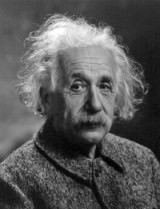One of the most amazing implications of Einstein’s relativity is the fact that the inertial mass of an object depends on its velocity. That sounds like a difficult thing to test, but that’s exactly what happened through a series of experiments performed by Kaufmann, Bucherer, Neumann and others.
Continue reading “Astronomy Cast Ep. 370: The Kaufmann–Bucherer–Neumann Experiments”
How Do We Know Dark Energy Exists?
We have no idea what it dark energy is, so how are we pretty sure it exists?
I’ve talked about how astronomers know that dark matter exists. Even though they can’t see it, they detect it through the effect its gravity has on light. Dark matter accounts for 27% of the Universe, dark energy accounts for 68% of the Universe. And again, astronomers really have no idea what what it is, only that they’re pretty sure it does exist. 95% of the nature of the Universe is a complete and total mystery. We just have no idea what this stuff is.
So this time around, lets focus on dark energy. Back in the late 90s, astronomers wanted to calculate once and for all if the Universe was open or closed. In other words, they wanted to calculate the rate of expansion of the Universe now and then compare this rate to its expansion in the past. In order to answer this question, they searched the skies for a special type of supernova known as a Type 1a.
While most supernovae are just massive stars, Type 1a are white dwarf stars that exist in a binary system. The white dwarf siphons material off of its binary partner, and when it reaches 1.6 times the mass of the Sun, it explodes. The trick is that these always explode with roughly the same amount of energy. So if you measure the brightness of a Type 1a supernova, you know roughly how far away it is.
Astronomers assumed the expansion was slowing down. But the question was, how fast was it slowing down? Would it slow to a halt and maybe even reverse direction? So, what did they discover?
In the immortal words of Isaac Asimov, “the most exciting phrase to hear in science, the one that heralds new discoveries, is not ‘Eureka’, but ‘That’s Funny’” Instead of finding that the expansion of the Universe was slowing down, they discovered that it’s speeding up. That’s like trying to calculate how quickly apples fall from trees and finding that they actually fly off into the sky, faster and faster.
Since this amazing, Nobel prize winning discovery, astronomers have used several other methods to verify this mind-bending reality of the Universe. NASA’s Wilkinson Microwave Anisotropy Probe studied the Cosmic Microwave Background Radiation of the Universe for 7 years, and put the amount of dark energy at 72.8% of the Universe. ESA’s Planck spacecraft performed an even more careful analysis and pegged that number at 68.3% of the Universe.
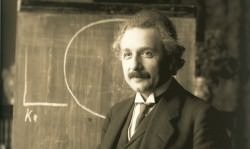
Astronomers know that dark energy exists. There are multiple lines of evidence. But as with dark matter, they have absolutely no clue what it is. Einstein described an idea he called the cosmological constant. It was a way to explain a static Universe that really should be expanding or contracting. Once astronomers figured out the Universe was actually expanding, he threw the idea out.
Hey, not so fast there “Einstein”. Maybe just one of the features of space itself is that it pushes stuff away. And the more space there is, the more outward pressure you get. Perhaps from virtual particles popping in and out of existence in the vacuum of space.
Another possibility is a phenomenon called Quintessence, a negative energy field that pervades the entire Universe. Yes, that sounds totally woo-woo, thanks Universe, Deepak Chopra crazy talk, but it might explain the repulsive force that makes up most of the Universe. And there are other theories, which are even more exotic. But mostly likely it’s something that physicists haven’t even thought of yet.
So, how do we know dark energy exists? Distant supernovae are a lot further away from each other than they should be if the expansion of the Universe was slowing down. Nobody has any idea what it is, it’s a mystery, and there’s nothing wrong with a mystery. In fact, for me, it’s one of the most exciting ideas in space and astronomy.
What do you think dark energy is?
How We’ve ‘Morphed’ From “Starry Night” to Planck’s View of the BICEP2 Field

From the vantage point of a window in an insane asylum, Vincent van Gogh painted one of the most noted and valued artistic works in human history. It was the summer of 1889. With his post-impressionist paint strokes, Starry Night depicts a night sky before sunrise that undulates, flows and is never settled. Scientific discoveries are revealing a Cosmos with such characteristics.
Since Vincent’s time, artists and scientists have taken their respective paths to convey and understand the natural world. The latest released images taken by the European Planck Space Telescope reveals new exquisite details of our Universe that begin to touch upon the paint strokes of the great master and at the same time looks back nearly to the beginning of time. Since Van Gogh – the passage of 125 years – scientists have constructed a progressively intricate and incredible description of the Universe.

The path from Van Gogh to the Planck Telescope imagery is indirect, an abstraction akin to the impressionism of van Gogh’s era. Impressionists in the 1800s showed us that the human mind could interpret and imagine the world beyond the limitations of our five senses. Furthermore, optics since the time of Galileo had begun to extend the capability of our senses.
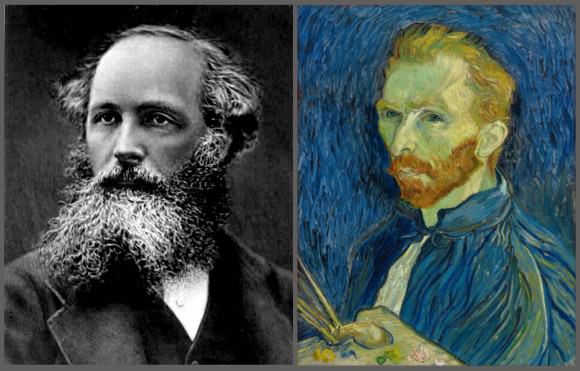
Mathematics is perhaps the greatest form of abstraction of our vision of the World, the Cosmos. The path of science from the era of van Gogh began with his contemporary, James Clerk Maxwell who owes inspiration from the experimentalist Michael Faraday. The Maxwell equations mathematically define the nature of electricity and magnetism. Since Maxwell, electricity, magnetism and light have been intertwined. His equations are now a derivative of a more universal equation – the Standard Model of the Universe. The accompanying Universe Today article by Ramin Skibba describes in more detail the new findings by Planck Mission scientists and its impact on the Standard Model.
The work of Maxwell and experimentalists such as Faraday, Michelson and Morley built an overwhelming body of knowledge upon which Albert Einstein was able to write his papers of 1905, his miracle year (Annus mirabilis). His theories of the Universe have been interpreted, verified time and again and lead directly to the Universe studied by scientists employing the Planck Telescope.
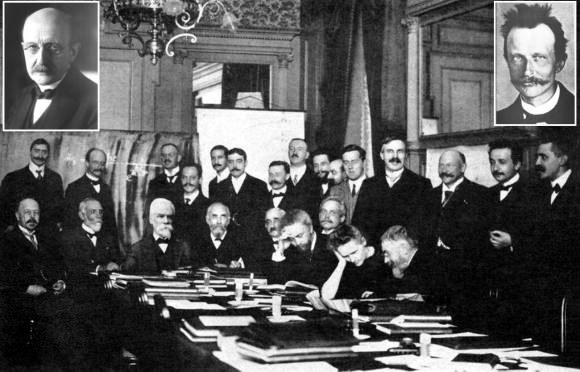
In 1908, the German physicist Max Planck, for whom the ESA telescope is named, recognized the importance of Einstein’s work and finally invited him to Berlin and away from the obscurity of a patent office in Bern, Switzerland.
As Einstein spent a decade to complete his greatest work, the General Theory of Relativity, astronomers began to apply more powerful tools to their trade. Edwin Hubble, born in the year van Gogh painted Starry Night, began to observe the night sky with the most powerful telescope in the World, the Mt Wilson 100 inch Hooker Telescope. In the 1920s, Hubble discovered that the Milky Way was not the whole Universe but rather an island universe, one amongst billions of galaxies. His observations revealed that the Milky Way was a spiral galaxy of a form similar to neighboring galaxies, for example, M31, the Andromeda Galaxy.
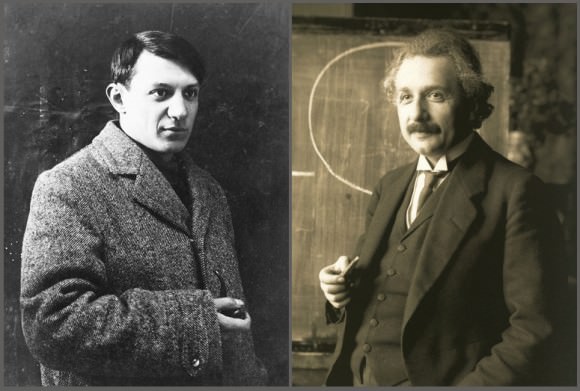
Einstein’s equations and Picasso’s abstraction created another rush of discovery and expressionism that propel us for another 50 years. Their influence continues to impact our lives today.
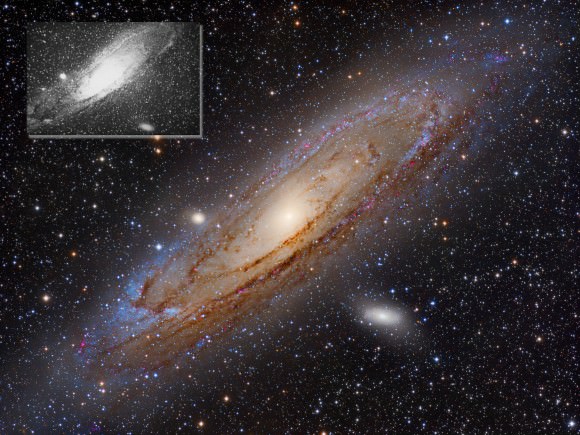
Telescopes of Hubble’s era reached their peak with the Palomar 200 inch telescope, four times the light gathering power of Mount Wilson’s. Astronomy had to await the development of modern electronics. Improvements in photographic techniques would pale in comparison to what was to come.
The development of electronics was accelerated by the pressures placed upon opposing forces during World War II. Karl Jansky developed radio astronomy in the 1930s which benefited from research that followed during the war years. Jansky detected the radio signature of the Milky Way. As Maxwell and others imagined, astronomy began to expand beyond just visible light – into the infrared and radio waves. Discovery of the Cosmic Microwave Background (CMB) in 1964 by Arno Penzias and Robert Wilson is arguably the greatest discovery from observations in the radio wave (and microwave) region of the electromagnetic spectrum.
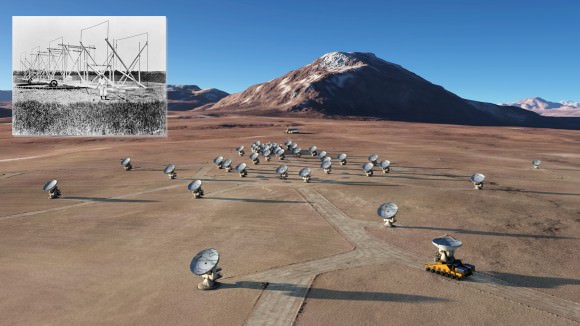
Analog electronics could augment photographic studies. Vacuum tubes led to photo-multiplier tubes that could count photons and measure more accurately the dynamics of stars and the spectral imagery of planets, nebulas and whole galaxies. Then in the 1947, three physicists at Bell Labs , John Bardeen, Walter Brattain, and William Shockley created the transistor that continues to transform the World today.
For astronomy and our image of the Universe, it meant more acute imagery of the Universe and imagery spanning across the whole electromagnetic spectrum. Infrared Astronomy developed slowly beginning in the 1800s but it was solid state electronics in the 1960s when it came of age. Microwave or Millimeter Radio Astronomy required a marriage of radio astronomy and solid state electronics. The first practical millimeter wave telescope began operations in 1980 at Kitt Peak Observatory.

With further improvements in solid state electronics and development of extremely accurate timing devices and development of low-temperature solid state electronics, astronomy has reached the present day. With modern rocketry, sensitive devices such as the Hubble and Planck Space Telescopes have been lofted into orbit and above the opaque atmosphere surrounding the Earth.
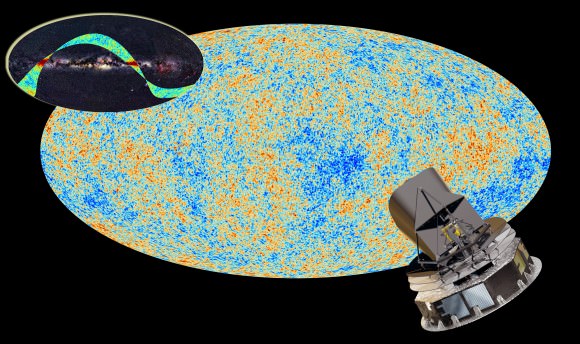
Astronomers and physicists now probe the Universe across the whole electromagnetic spectrum generating terabytes of data and abstractions of the raw data allow us to look out into the Universe with effectively a sixth sense, that which is given to us by 21st century technology. What a remarkable coincidence that the observations of our best telescopes peering through hundreds of thousands of light years, even more so, back 13.8 billion years to the beginning of time, reveal images of the Universe that are not unlike the brilliant and beautiful paintings of a human with a mind that gave him no choice but to see the world differently.
Now 125 years later, this sixth sense forces us to see the World in a similar light. Peer up into the sky and you can imagine the planetary systems revolving around nearly every star, swirling clouds of spiral galaxies, one even larger in the sky than our Moon, and waves of magnetic fields everywhere across the starry night.
Consider what the Planck Mission is revealing, questions it is answering and new ones it is raising – It Turns Out Primordial Gravitational Waves Weren’t Found.
How are Energy and Matter the Same?
As Einstein showed us, light and matter and just aspects of the same thing. Matter is just frozen light. And light is matter on the move. How does one become the other?
Albert Einstein’s most famous equation says that energy and matter are two sides of the same coin.
But what does that really mean? And how are equations famous? I like to believe equations can be famous in the way a work of art, or a philosophy can be famous. People can have awareness of the thing, and yet never have interacted with it. They can understand that it is important, and yet not understand why it’s so significant. Which is a little too bad, as this is really a lovely mind bending idea.
The origin of E=mc2 lies in special relativity. Light has the same speed no matter what frame of reference you are in. No matter where you are, or how fast you’re going. If you were standing still at the side of the road, and observed a car traveling at ¾ light speed, you would see the light from their headlights traveling away from them at ¼ the speed of light.
But the driver of the car would still see that the light moving ahead of them at the speed of light. This is only possible if their time appears to slow down relative to you, and you and the people in the car can no longer agree on how long a second would take to pass.
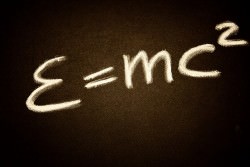
So the light appears to be moving away from them more slowly, but as they experience things more slowly it all evens out. This also affects their apparent mass. If they step on the gas, they will speed up more slowly than you would expect. It’s as if the car has more mass than you expect. So relativity requires that the faster an object moves, the more mass it appears to have. This means that somehow part of the energy of the car’s motion appears to transform into mass. Hence the origin of Einstein’s equation. How does that happen? We don’t really know. We only know that it does.
The same effect occurs with quantum particles, and not just with light. A neutron, for example, can decay into a proton, electron and anti-neutrino. The mass of these three particles is less than the mass of a neutron, so they each get some energy as well. So energy and matter are really the same thing. Completely interchangeable. And finally, Although energy and mass are related through special relativity, mass and space are related through general relativity. You can define any mass by a distance known as its Schwarzschild radius, which is the radius of a black hole of that mass. So in a way, energy, matter, space and time are all aspects of the same thing.
What do you think? Like E=mc2, what’s the most famous idea you can think of in physics?
And if you like what you see, come check out our Patreon page and find out how you can get these videos early while helping us bring you more great content!
What Time is It in the Universe?
Check your watch, what time is it? But wait, you’ve actually been moving and accelerating, and according to Einstein, everything’s relative. So what time is it really? It all depends…
Flavor Flav knows what time it is. At least he does for Flavor Flav. Even with all his moving and accelerating, with the planet, the solar system, getting on planes, taking elevators, and perhaps even some light jogging. In the immortal words of Kool Moe Dee. Do you know what time it is?
Didn’t Einstein tell us it’s all relative? Does anyone actually know what time it is? I mean, aside from figuratively, or in a political sense, or perhaps as part of rap performance from whence the power is being fought from, requiring the sick skills of a hype man wearing a clock around his neck on a big chain.
So, after all my fancy dancing and longing for a time in rap and hip hop from days gone by, I must present to you “faithful audience member” an answer in the form of your 3 least favorite words I get to deliver.
It all depends…
You have heard that everything is relative, usually we hear it from people who like to talk about “connections on many different levels”, which is just nonsense.
But in physics “everything” is relative in a very particular way. Everything is relative to the speed of light, which is the same in every reference frame. Which is confusing and repeated enough that it can become meaningless.
So I’m going to do my best to explain it. If I shine a flashlight in front of me, I will measure the beam to travel at about 300,000 km/s, which is also known as the speed of light.
And if you are moving at 200,000 km/s faster than me, and shine a flashlight ahead of you, I will see the light from your flashlight moving at the 300,000km/s. It will appear to me, as though the light from your flashlight is moving away from you at 100,000 km/s.
But when you will measure the speed of that light, relative to you, you’d think it’d be moving at 100,000 km/s as well, but instead from your perspective it will ALSO clock in at 300,000 km/s.
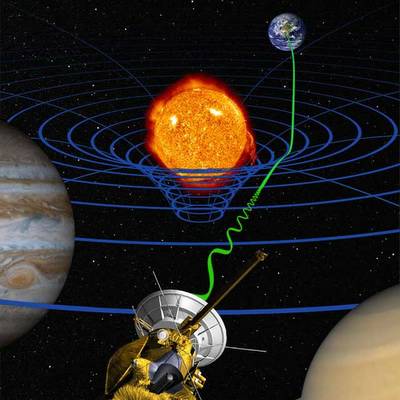
The speed of light. How is this even possible? It is possible in part because the rate at which you experience time relative to me changes. For you, time will seem normal, but from my perspective your time will seem slower. We agree on how fast light is moving in kilometers per second, but we disagree how long a second is. We also, by the way, disagree on the length of a meter.
This seems strange because we imagine that space and time are absolute things, and light is something that travels through space. This is our experience. Suggesting things like time and space are malleable values at best is unsettling and at worst will make us nanners from thinking too much about.
Hold on to your tinfoil hats, for it is in fact light that is the absolute, and space and time are relative to it. So what time it is depends upon your vantage point, and so there is no single absolute time.
Finally, because of relativity, each point in the Universe experiences time at a slightly different rate. For example, when we observe the cosmic microwave background, we find that we are moving at a speed of about 630 km/s relative to the background. That means we experience time a bit more slowly that something at rest relative to the cosmic background.
It’s just a tiny bit slower, but added over the entire age of the Universe, our cosmic clock is 30,000 years behind the times. Feel free to set your watch. But don’t get too precise about it. Your time could be off by tens of thousands of years.
What about you? What’s your favorite way to explain special relativity to someone. Tell us in the comments below.
Does Light Experience Time?
Have you ever noticed that time flies when you’re having fun? Well, not for light. In fact, photons don’t experience any time at all. Here’s a mind-bending concept that should shatter your brain into pieces.
As you might know, I co-host Astronomy Cast, and get to pick the brain of the brilliant astrophysicist Dr. Pamela Gay every week about whatever crazy thing I think of in the shower. We were talking about photons one week and she dropped a bombshell on my brain. Photons do not experience time. [SNARK: Are you worried they might get bored?]
Just think about that idea. From the perspective of a photon, there is no such thing as time. It’s emitted, and might exist for hundreds of trillions of years, but for the photon, there’s zero time elapsed between when it’s emitted and when it’s absorbed again. It doesn’t experience distance either. [SNARK: Clearly, it didn’t need to borrow my copy of GQ for the trip.]
Since photons can’t think, we don’t have to worry too much about their existential horror of experiencing neither time nor distance, but it tells us so much about how they’re linked together. Through his Theory of Relativity, Einstein helped us understand how time and distance are connected.
Let’s do a quick review. If we want to travel to some distant point in space, and we travel faster and faster, approaching the speed of light our clocks slow down relative to an observer back on Earth. And yet, we reach our destination more quickly than we would expect. Sure, our mass goes up and there are enormous amounts of energy required, but for this example, we’ll just ignore all that.
If you could travel at a constant acceleration of 1 g, you could cross billions of light years in a single human generation. Of course, your friends back home would have experienced billions of years in your absence, but much like the mass increase and energy required, we won’t worry about them.
The closer you get to light speed, the less time you experience and the shorter a distance you experience. You may recall that these numbers begin to approach zero. According to relativity, mass can never move through the Universe at light speed. Mass will increase to infinity, and the amount of energy required to move it any faster will also be infinite. But for light itself, which is already moving at light speed… You guessed it, the photons reach zero distance and zero time.
Photons can take hundreds of thousands of years to travel from the core of the Sun until they reach the surface and fly off into space. And yet, that final journey, that could take it billions of light years across space, was no different from jumping from atom to atom.
There, now these ideas can haunt your thoughts as they do mine. You’re welcome. What do you think? What’s your favorite mind bending relativity side effect? Tell us in the comments below.
Astronomy Cast Ep. 335: Photoelectric Effect
Pop quiz. How did Einstein win his Nobel prize? Was it for relativity? Nope, Einstein won the Nobel Prize in 1921 for the discovery of the photoelectric effect; how electrons are emitted from atoms when they absorb photons of light. But what is it? Let’s find out.
Continue reading “Astronomy Cast Ep. 335: Photoelectric Effect”
Why Einstein Will Never Be Wrong
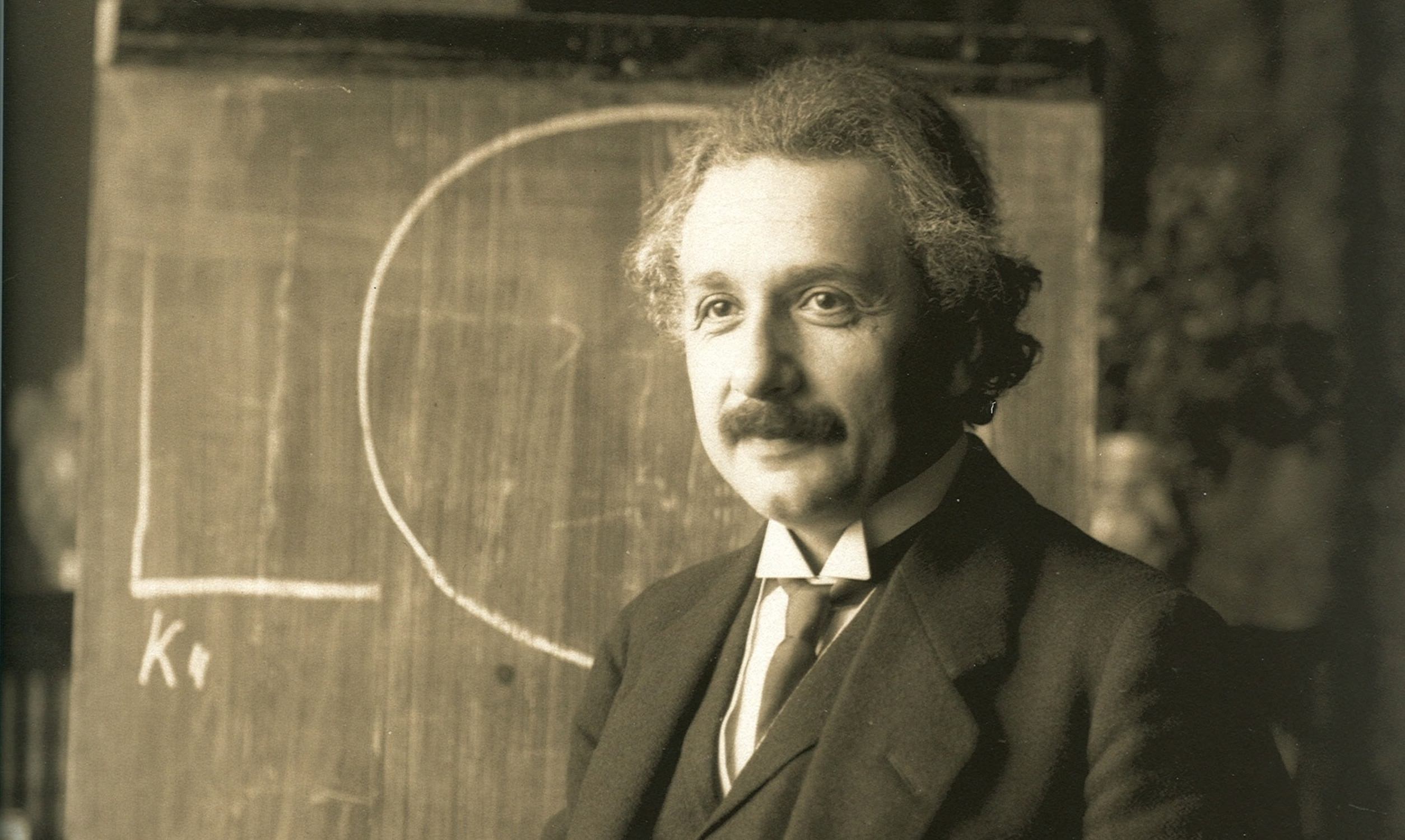
One of the benefits of being an astrophysicist is your weekly email from someone who claims to have “proven Einstein wrong”. These either contain no mathematical equations and use phrases such as “it is obvious that..”, or they are page after page of complex equations with dozens of scientific terms used in non-traditional ways. They all get deleted pretty quickly, not because astrophysicists are too indoctrinated in established theories, but because none of them acknowledge how theories get replaced.
For example, in the late 1700s there was a theory of heat known as caloric. The basic idea of caloric was that it was a fluid that existed within materials. This fluid was self-repellant, meaning it would try to spread out as evenly as possible. We couldn’t observe this fluid directly, but the more caloric a material has the greater its temperature.

From this theory you get several predictions that actually work. Since you can’t create or destroy caloric, heat (energy) is conserved. If you put a cold object next to a hot object, the caloric in the hot object will spread out to the cold object until they reach the same temperature. When air expands, the caloric is spread out more thinly, thus the temperature drops. When air is compressed there is more caloric per volume, and the temperature rises.
We now know there is no “heat fluid” known as caloric. Heat is a property of the motion (kinetic energy) of atoms or molecules in a material. So in physics we’ve dropped the caloric model in terms of kinetic theory. You could say we now know that the caloric model is completely wrong.
Except it isn’t. At least no more wrong than it ever was.
The basic assumption of a “heat fluid” doesn’t match reality, but the model makes predictions that are correct. In fact the caloric model works as well today as it did in the late 1700s. We don’t use it anymore because we have newer models that work better. Kinetic theory makes all the predictions caloric does and more. Kinetic theory even explains how the thermal energy of a material can be approximated as a fluid.
This is a key aspect of scientific theories. If you want to replace a robust scientific theory with a new one, the new theory must be able to do more than the old one. When you replace the old theory you now understand the limits of that theory and how to move beyond it.
In some cases even when an old theory is supplanted we continue to use it. Such an example can be seen in Newton’s law of gravity. When Newton proposed his theory of universal gravity in the 1600s, he described gravity as a force of attraction between all masses. This allowed for the correct prediction of the motion of the planets, the discovery of Neptune, the basic relation between a star’s mass and its temperature, and on and on. Newtonian gravity was and is a robust scientific theory.
Then in the early 1900s Einstein proposed a different model known as general relativity. The basic premise of this theory is that gravity is due to the curvature of space and time by masses. Even though Einstein’s gravity model is radically different from Newton’s, the mathematics of the theory shows that Newton’s equations are approximate solutions to Einstein’s equations. Everything Newton’s gravity predicts, Einstein’s does as well. But Einstein also allows us to correctly model black holes, the big bang, the precession of Mercury’s orbit, time dilation, and more, all of which have been experimentally validated.
So Einstein trumps Newton. But Einstein’s theory is much more difficult to work with than Newton’s, so often we just use Newton’s equations to calculate things. For example, the motion of satellites, or exoplanets. If we don’t need the precision of Einstein’s theory, we simply use Newton to get an answer that is “good enough.” We may have proven Newton’s theory “wrong”, but the theory is still as useful and accurate as it ever was.
Unfortunately, many budding Einsteins don’t understand this.
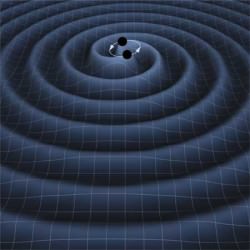
To begin with, Einstein’s gravity will never be proven wrong by a theory. It will be proven wrong by experimental evidence showing that the predictions of general relativity don’t work. Einstein’s theory didn’t supplant Newton’s until we had experimental evidence that agreed with Einstein and didn’t agree with Newton. So unless you have experimental evidence that clearly contradicts general relativity, claims of “disproving Einstein” will fall on deaf ears.
The other way to trump Einstein would be to develop a theory that clearly shows how Einstein’s theory is an approximation of your new theory, or how the experimental tests general relativity has passed are also passed by your theory. Ideally, your new theory will also make new predictions that can be tested in a reasonable way. If you can do that, and can present your ideas clearly, you will be listened to. String theory and entropic gravity are examples of models that try to do just that.
But even if someone succeeds in creating a theory better than Einstein’s (and someone almost certainly will), Einstein’s theory will still be as valid as it ever was. Einstein won’t have been proven wrong, we’ll simply understand the limits of his theory.
Einstein Right Again! Rapidly Spinning Pulsar Follows General Relativity
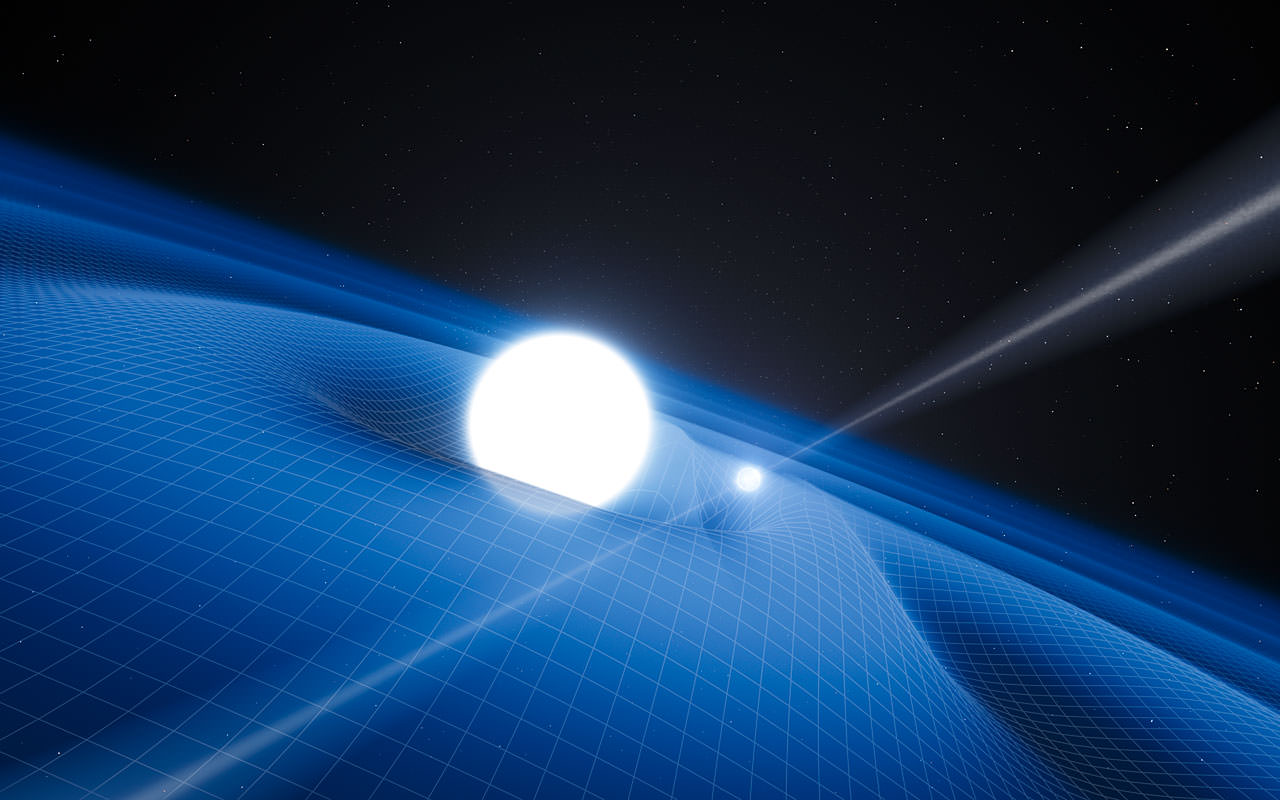
A unique and exotic laboratory about 6,800 light-years from Earth is helping Earth-based astronomers test Albert Einstein’s theory of general relativity in ways not possible until now. And the observations exactly match predictions from general relativity, say scientists in a paper to be published in the April 26 issue of the journal Science.
Using ESO’s Very Large Telescope along with other radio telescopes, John Antoniadis, a PhD student at the Max Planck Institute for radio Astronomy (MPIfR) in Bonn and lead author of the paper, says the bizarre pair of stars makes for an excellent test case for physics.
“I was observing the system with ESO’s Very Large Telescope, looking for changes in the light emitted from the white dwarf caused by its motion around the pulsar,” says Antoniadis. “A quick on-the-spot analysis made me realize that the pulsar was quite a heavyweight. It is twice the mass of the Sun, making it the most massive neutron star that we know of and also an excellent laboratory for fundamental physics.”
The strange pair consists of a tiny and unusually heavy neutron star that spins 25 times per second. The pulsar, named PSR J0348+0432 is the remains of a supernova explosion. Twice as heavy as our Sun, the pulsar would fit within the confines of the Denver metropolitan area; it’s just 20 kilometers across or about 12 miles. The gravity on this strange star is more than 300 billion times stronger than on Earth. At its center, where the intense gravity squeezes matter even more tightly together, a sugar-cubed-sized block of star stuff would weight more than one billion tons. Only three other pulsars outside globular clusters spin faster and have shorter periods.
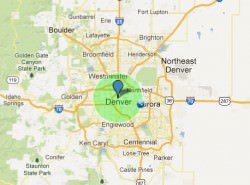
As a consequence, radio astronomers Ryan Lynch and colleagues who discovered the pulsar in 2011, realized the pair would enable scientists to test theories of gravity that were not possible before. Einstein’s general theory of relativity describes gravity as a curvature in spacetime. Like a bowling ball nestled in a stretched bedsheet, spacetime bends and warps in the presence of mass and energy. The theory, published in 1916, has withstood all tests so far as the simplest explanation for observed astronomical phenomena. Other theories of gravity make different predictions but these differences would reveal themselves only in extremely strong gravitational fields not found within our solar system. J0348+0432 offered the opportunity to study Einstein’s theory in detail.
This video shows an artist’s impression of the exotic double object known as PSR J0348+0432. This system is radiating gravitational radiation, or ripples, in spacetime. Although these waves cannot be yet detected directly by astronomers on Earth they can be detected indirectly by measuring the change in the orbit of the system as it loses energy. Credit: ESO/L.Calçada
Antoniadis’ team combined observations of the white dwarf from the European Southern Observatory’s Very Large Telescope with the precise timing of the pulsar from other radio telescopes, including the Green Bank Telescope in West Virginia, Effelsberg 100 meter radio telescope in Germany, and the Arecibo Observatory in Puerto Rico. Astronomers predict such close pulsar binaries radiate gravity waves and lose minute amounts of energy over time causing the orbital period of the white dwarf companion to change slightly. The astronomers found that predictions for this change closely matched those of general relativity while competing theories were different.
“Our radio observations were so precise that we have already been able to measure a change in the orbital period of 8 millionths of a second per year, exactly what Einstein’s theory predicts,” states Paulo Freire, another team member, in the press release.
Sources:
ESO: Einstein Was Right – So Far
Astrophysical Journal: The Green Bank Telescope 350 MHz Drift-scan Survey II: Data Analysis and the Timing of 10 New Pulsars, Including a Relativistic Binary
Aspen Center for Physics Physical Application of Millisecond Pulsars meeting January 2013: The Compact Relativistic Binary PSR J0348+0432
Spooky Experiment on ISS Could Pioneer New Quantum Communications Network

With its 180 degree views of Earth and space, the ISS’s cupola is the perfect place for photography. But Austrian researchers want to use the unique and panoramic platform to test the limits of “spooky action at distance” in hopes of creating a new quantum communications network.
In a new study published April 9, 2012 in the New Journal of Physics, a group of Austrian researchers propose equipping the camera that is already aboard the ISS — the Nikon 400 mm NightPOD camera — with an optical receiver that would be key to performing the first-ever quantum optics experiment in space. The NightPOD camera faces the ground in the cupola and can track ground targets for up to 70 seconds allowing researchers to bounce a secret encryption key across longer distances than currently possible with optical fiber networks on Earth.
“During a few months a year, the ISS passes five to six times in a row in the correct orientation for us to do our experiments. We envision setting up the experiment for a whole week and therefore having more than enough links to the ISS available,” said co-author of the study Professor Rupert Ursin from the Austrian Academy of Sciences.
Albert Einstein first coined the phrase ‘spooky action at a distance’ during his philosophical battles with Neils Bohr in the 1930s to explain his frustration with the inadequacies of the new theory called quantum mechanics. Quantum mechanics explains actions on the tiniest scales in the domain of atoms and elemental particles. While classical physics explains motion, matter and energy on the level that we can see, 19th century scientists observed phenomena in both the macro and micro world that could not easily explained using classical physics.
In particular, Einstein was dissatisfied with the idea of entanglement. Entanglement occurs when two particles are so deeply connected that they share the same existence; meaning that they share the same mathematical relationships of position, spin, momentum and polarization. This could happen when two particles are created at the same point and instant in spacetime. Over time, as the two particles become widely separated in space, even by light-years, quantum mechanics suggests that a measurement of one would immediately impact the other. Einstein was quick to point out that this violated the universal speed limit set out by special relativity. It was this paradox Einstein referred to as spooky action.
CERN physicist John Bell partially resolved this mystery in 1964 by coming up with the idea of non-local phenomena. While entanglement allows one particle to be instantaneously influenced by its exact counterpart, the flow of classical information does not travel faster than light.
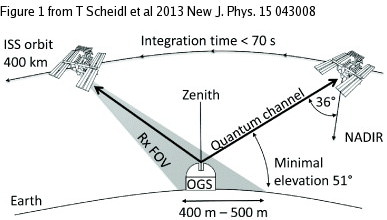
“According to quantum physics, entanglement is independent of distance. Our proposed Bell-type experiment will show that particles are entangled, over large distances — around 500 km — for the very first time in an experiment,” says Ursin. “Our experiments will also enable us to test potential effects gravity may have on quantum entanglement.”
The researchers point out that making the minor alteration to a camera already aboard the ISS will save time and money needed to build a series of satellites to test researchers’ ideas.


